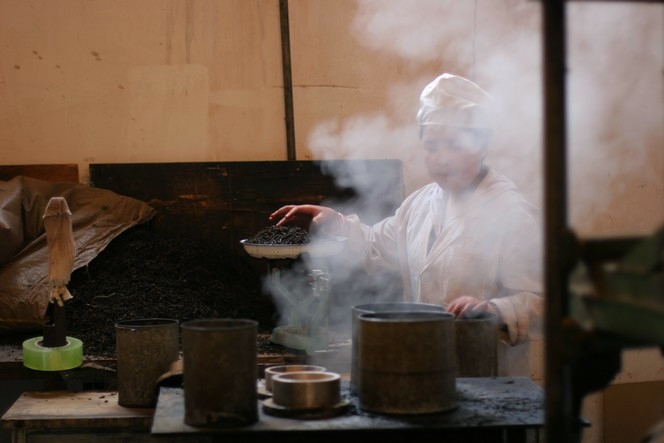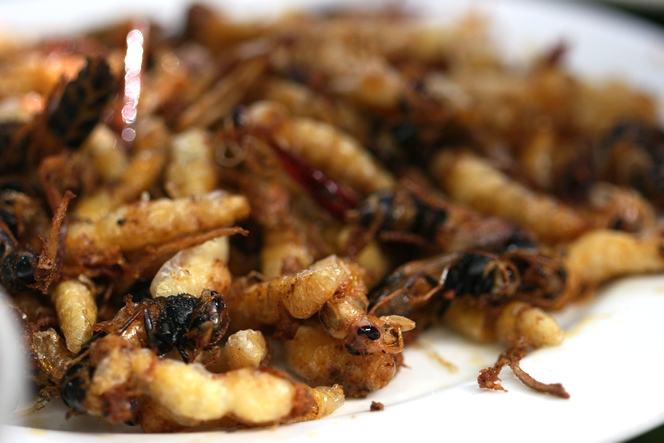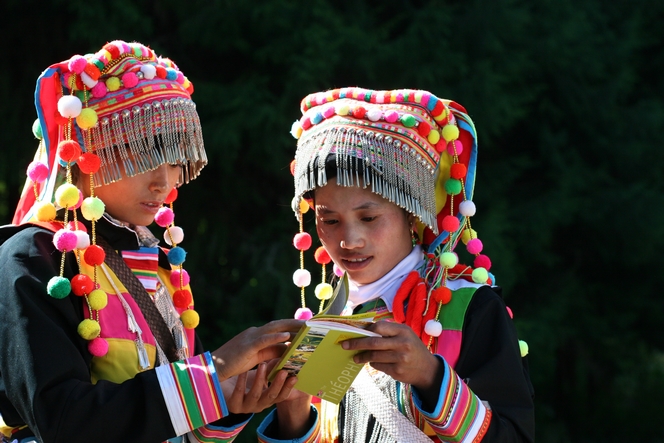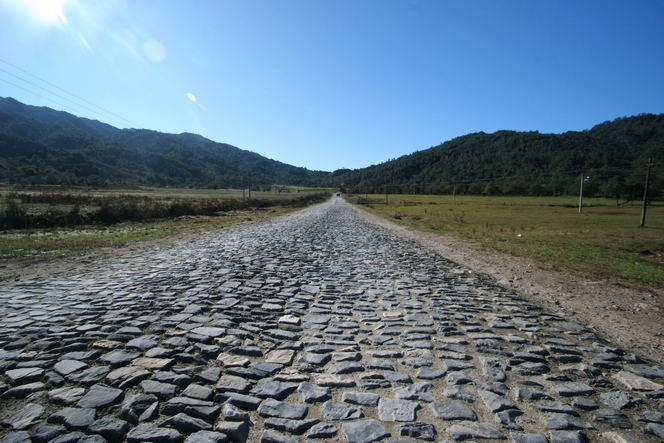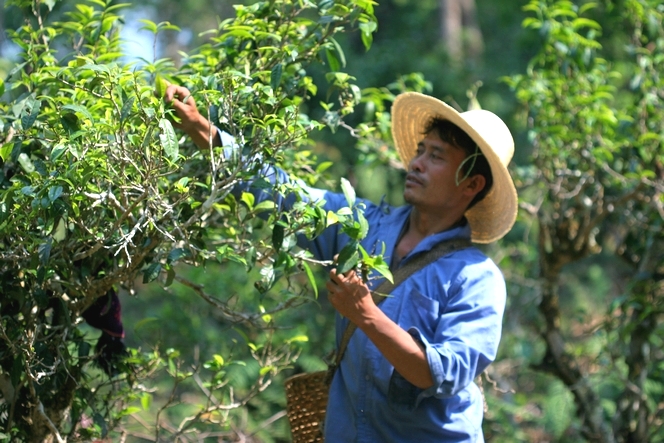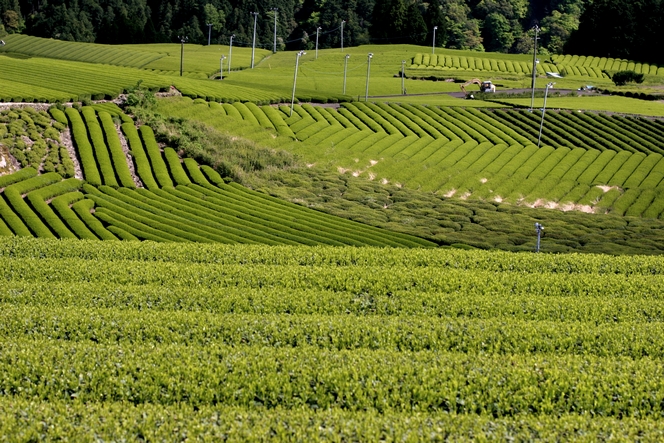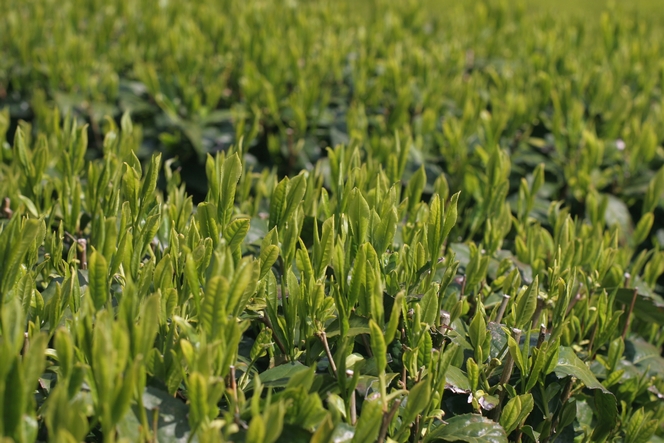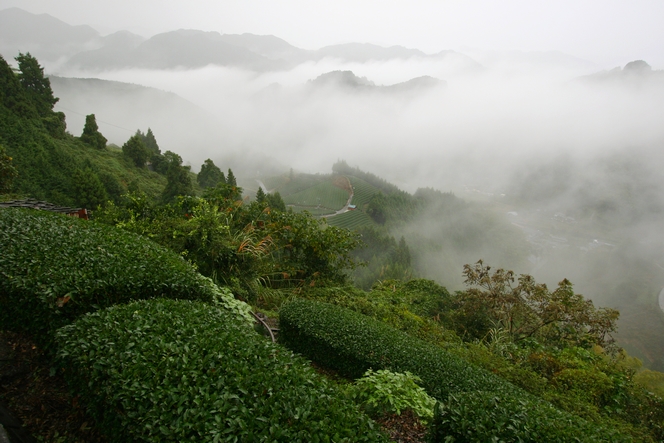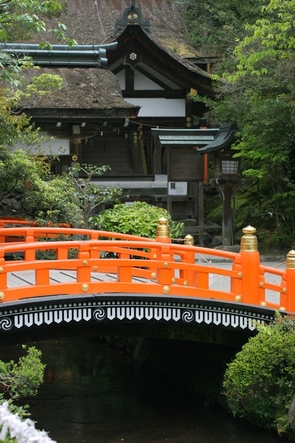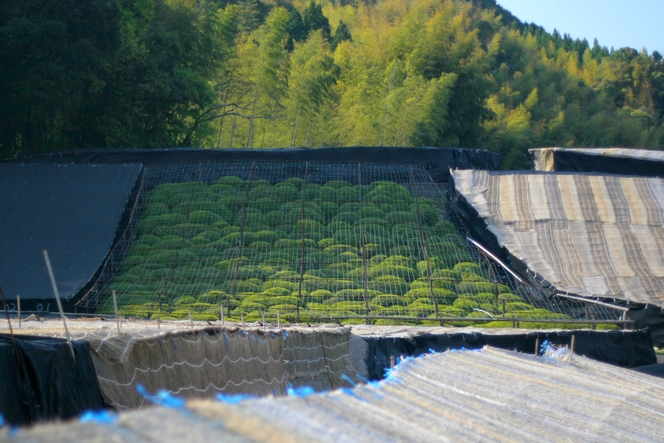Traditionally, Pu Er tea is sold in “cake” form that weighs 357 grams. Here, you can see the first stage in the manufacturing process: the woman weighs the tea to the nearest gram, then tips the exact quantity into a metal cylinder with a perforated base, which she places above a source of steam. On contact with the steam, the tea leaves soften and are then are ready to be compressed.
Pan-fried hornets with chilli and garlic
Part of the experience of travelling is escaping from your usual routines. What a joy to be able to discover the habits and customs of our fellow men! Here is one such example…
While stopping off in Lisu (China) I was honoured to be invited to lunch at a little riverside restaurant, a short distance from the main road on which we were travelling. There, in the peaceful surroundings with only the gurgling of the stream and the enthusiastic trilling of a couple of mynah birds to distract me, I waited to see what my hosts had ordered.
For those who one day might travel to this part of our beautiful planet, I feel a bit guilty for spoiling the inevitable surprise and pleasure of discovering a dish so little known in our own country, despite its wealth of gastronomic curiosities. But given that hornets – for this was the local delicacy in question – are so common in the south of France, it seems a shame to deprive our friends in Provence of a recipe that is so easy to prepare and would not fail to impress their guests. And as we approach the end-of-year festivities, which are always upon us sooner than expected, are we not looking for a more unusual festive dish to make a nice change from turkey or capon?
Here’s an extract from my tasting notes: “A particularly intense contrast between the head of the insect (one of which is at least 10 cm long) and its abdomen. The head, grilled to perfection, is crunchy in the mouth, while the creamy substance that escapes from its abdomen lines the palate, coating the tongue in a thick, generous matter that slowly develops lingering aromas…”
Accompaniment suggestion: I think a “Bourgeons de Yunnan” tea would suit perfectly with our dish.
The Lisus climb giant tea plants
Many ethnic groups live alongside one another in the province of Yunnan (China). The Hans are there of course, as is the case across China, but at least 20 minority groups live there too, including the Dais, Miaos, Nus, Huis, Was and Yis. Here, on the border between China and Myanmar (Burma), we are with the Lisus.
These people live from farming in the remote mountainous regions. They also grow tea, or rather, they harvest the leaves that grow on giant tea plants. It is an incredible sight to see them in their traditional costumes climbing to the tops of trees 10 or 20 metres high, wicker baskets on their backs, working away. It makes you hold your breath.
Here, I have caught two Lisus women closely examining the Théophile Guide. They are looking at the list of stores on the back cover with quite serious expressions that contrast with the strings of brightly coloured fluffy balls that swing gently on either side of their faces.
The long road to the Pu Er plantations
The Pu Er plantations are not an easy place to visit, but they are worth it. The tea leaves used to make Pu Er grow in the remote regions of Yunnan, mainly in Simao, Lincang, Xishuangbanna and near Da Hong. It was Da Hong I visited this month, an experience I shall never forget. Da Hong is an hour’s flight from Kunming, which is nothing, but you then need to drive for at least eight hours to see the famous tea plants. At first you drive along a motorway under construction, so all you see is the golden dust thrown up by the vehicle in front. Visibility is reduced to just a few metres, and what’s more, you have to swerve around all the potholes. These testing conditions last for a good 100 kilometres, and you must hurry as the road closes at a set time to let the bulldozers in. If you arrive at the barricade too late, you have to do a U-turn and try again the next day. But if you get past all these obstacles in one piece, a magical landscape awaits you the other end. With the altitude, the air cools, and the stunning mountain drive makes you forget what came before. The vegetation changes, conifers appear, and then you come out onto the magnificent high plateaux.
Buffalo and horses roam free, and donkeys cross the pretty paved road whenever they feel like it. It gives you an overwhelming sense of freedom. It is time to take a break. It is a long road to Pu Er. The day has been exhausting, so we walk a little, filling our lungs with the pure air we lacked during the day, and allowing our gaze to wander to the distant horizon. Tomorrow we will be back on the road and cross a few more mountains to reach Su Dian, a few dozen kilometres from Myanmar. There, waiting for us, are people who are little known outside their region.
Semi-wild tea plants in Yunnan
The harvesting of leaves used to make Pu Er is interesting. Here, in the west of Yunnan near the border with Myanmar, the tea plants are left in a semi-wild state, and the plucking consists of a walk through the forest. Instead of keeping the tea plants cropped at a convenient height for harvesting, as is usually the case, they are left to grow into trees, or always have been, and the workers walk around them to pluck the bud and the next two leaves, as is the practice with all other teas.
Rows of perfectly aligned tea plants in Japan
Just before leaving Japan for China, here is a last glimpse of the landscape shaped by tea. Here, the rows of tea plants are precisely aligned. All is in perfect order, with a few organised clumps here and there, as if to underline the overall harmony. What I love most are the subtle nuances of green, the different shades of the same colour, a touch more yellow where the shoots are still young, slightly darker green where the leaves have recently been plucked.
Yabukita: the most popular cultivar in Japan
While all tea plants belong to the camellia family, you know that there are different cultivars within that family. Here in Japan, the tea plant most commonly grown is Yabukita. It accounts for 85% of the tea crop, unlike in other tea producing countries, where many different varieties cohabit.
Yabukita is easy to recognise with its long, straight, intense green leaf. It also has its own way of growing, very straight, reaching up for the sky.
In Ryogôchi: high quality Gyokuro and Sencha teas
A typhoon has just swept through Japan, from the south to the north. I don’t know what delayed it, because it was very late; typhoons normally hit Japan in September. Violent winds flip your umbrella inside out and rain drenches you from head to toe.
It seems I didn’t choose the best day to visit Ryogôchi and admire these mountains, where some very high quality Gyokuro and Sencha teas are grown. However, this abundance of clouds does add to the mystery of the place. Although the village itself is slightly hidden, along with the river Okitsugawa, you can still make out some shapes, and it is very Japanese to suggest, rather than to assert.
Kyoto: a city where time stands still
I am writing this in the city where time stands still, where thousands of temples are hidden, where the gardens are of moss or of stone, but always invite contemplation. Here, everything is silent, beautiful, refined.
Those on a journey of self-discovery can loose themselves among the narrow paved streets. Will you see reflected in the surface of the stream the geisha about to cross the bridge, her face whitened with rice powder and protected from the sun by a delicate parasol? Will you hear the clicking of her pretty wooden clogs? They echo to the beating of a heart: perhaps mine, perhaps yours. This is Kyoto.
In Japan, some teas are deprived of light
In Japan, there are teas grown in the light, and teas grown in the shade. These shaded teas, which are called “Kabusecha” here, are deprived of light for three weeks before harvest. This inhibits the process of photosynthesis in the leaves, meaning the tea plant must draw heavily on its own store of nutrients. This changes the chemical composition of the leaves as well as the aromatic properties.
In terms of flavour, it makes the tea smoother and more delicate, and it develops less bitterness. The best known “Kabusecha” tea is called Gyokuro, which has distinctive dark green, fine, glossy leaves.
In this photo I took very near Shizuoka, you can see how some of the tea plants have been covered by a large tarpaulin to shade them from the light.

